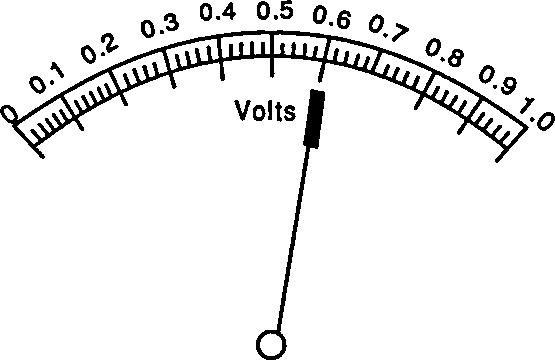
4 minute read
Transformers
CHAPTER 4 Troubleshooting Dry-Type Transformers
Dry-type transformers are a part of most electrical installations. They range in size from small doorbell transformers to three-phase 25-kVA units installed in electrical closets (Figure 4-1) to large, free-standing units rated at several hundred kVA (Figure 4-2). Electricians must know how to test for and diagnose problems that develop in transformers—especially in the smaller, drytype power-supply or control transformers. Open Circuit
Advertisement
If one of the windings in a transformer develops a break or “open” condition, no current can flow and therefore, the transformer will not deliver any output. The symptom of an open-circuited transformer is that the circuits, which derive power from the transformer, are de-energized or “dead.” Use an AC voltmeter or DMM to check across the transformer output terminals, as shown in Figure 4-3. A reading of 0 V indicates an open circuit.
Then take a voltage reading across the input terminals. If voltage is present, this indicates that one 49
4-1 Dry-type transformer (25-kVA, three-phase). (Courtesy of Square D Company.)
of the transformer windings is open. However, if there is no voltage reading on the input terminals either, then the open must be somewhere else on the line side of the circuit; possibly a disconnect switch is open.
50

4-2 Dry-type transformer (300-kVA, t h r e e - p h a s e ) . (Cour tesy of Square D Company.)
WARNING!
Make absolutely certain that your testing instruments are designed for the job and are calibrated for the correct voltage. Never test the primary side of any transformer over 600 V unless you are qualified, have the correct high-voltage testing instruments, and the test is made under the proper supervision.
51
0.0 Volt
4-3 Checking for an open circuit in a transformer.
However, if voltage is present on the line or primary side and no voltage is on the secondary or load side, open the switch to de-energize the circuit, and place a warning tag (tag-out and lock) on this switch so that it is not inadvertently closed again while someone is working on the circuit. Disconnect all of the transformer primary and secondary leads and check each winding in the transformer for continuity (a continuous circuit), as indicated by a resistance reading taken with an ohmmeter.
Continuity is indicated by a relatively low resistance reading on control transformers, while an open winding will be indicated by an infinite resistance reading (OL or 1). In most cases, such small transformers will 52
have to be replaced, unless of course the break is accessible and can be repaired. Ground Fault
Sometimes a few turns in the secondary winding of a transformer experience a partial short, which in turn causes a voltage drop across the secondary. The usual symptom of this condition is transformer overheating caused by large circulating currents flowing in the shorted windings.
The easiest way to check this condition is with a voltmeter. Take a reading on the line or primary side of the transformer first to make certain normal voltage is present. Then take a reading on the secondary side. If the transformer has a partial short or ground fault, the secondary voltage reading will be lower than normal.
Replace the faulty transformer with a new one and again take a reading on the secondary. If the voltage reading is now normal and the circuit operates satisfactorily, leave the replacement transformer in the circuit, and either discard or repair the original transformer. Complete Short
Occasionally a transformer winding becomes completely shorted. In most cases, this activates the overcurrent-protective device (circuit breaker or fuse) and de-energizes the circuit. But in some cases, the transformer may continue trying to operate with excessive overheating—due to the very large circulating current. This heat will often melt the insulation inside the transformer, which is easily detected by the odor. Also, there will be no voltage output across the 53
shorted winding and the secondary circuit supplied by that winding will be dead.
The short may be in the external secondary circuit or it may be in the transformer’s winding. To determine its location, disconnect the secondary circuit from the winding and take a reading with a voltmeter. If the voltage is normal with the external circuit disconnected, then the problem is in the external circuit. However, if the voltage reading is still zero across the secondary leads, the transformer is shorted and must be replaced.
Grounded Windings
Insulation breakdown is quite common in older transformers—especially those that have been overloaded. At some point, insulation breaks or deteriorates and bare conductors become exposed. The exposed wire often comes into contact with the transformer housing and grounds the winding.
If a winding develops a ground, and a point in the external circuit connected to this winding is also grounded, part of the winding will be shorted out. The symptoms are overheating, usually detected by feel or smell, and a low voltage reading as indicated on a voltmeter scale. In most cases, transformers with this condition must be replaced.
A megohmmeter is used to test for this condition. Disconnect the leads from both the primary and secondary windings. Tests can then be performed on either winding by connecting the megger negative test lead to an associated ground and the positive test lead to the winding to be measured.
54
Insulation resistance should then be measured between the windings themselves, by connecting one test lead to the primary and the second test lead to the secondary.
The troubleshooting chart in Figure 4-4 covers the most common dry-type transformer problems.

4-4 Troubleshooting chart for dry-type transformers.
55

4-4 Troubleshooting chart for dry-type transformers. (Continued) 56







